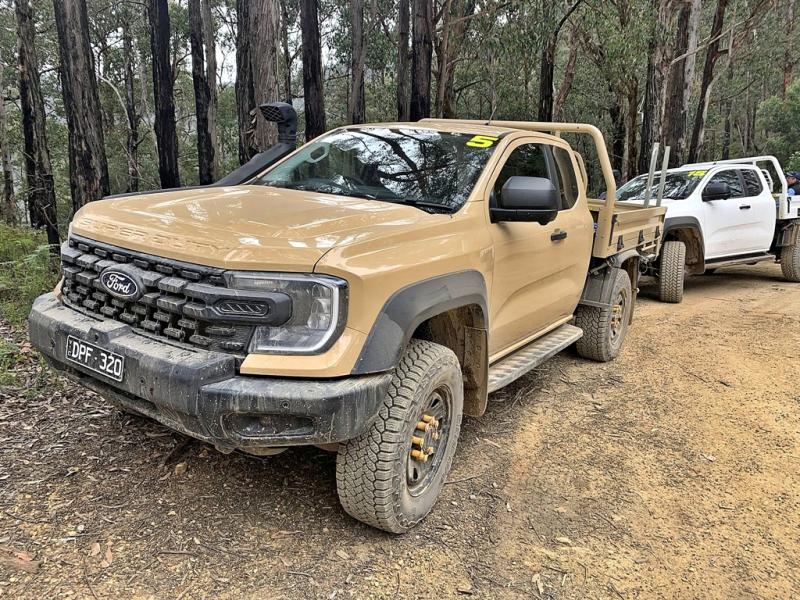Story and photos by Ashley Lucas
Front on it may look like a delivery van on steroids, but the Iveco Daily 4x4 is certainly no city slicker.
At over 2.6m tall unladen, the Daily 4x4 is never going to fit into a city carpark building. With off-road ability and huge payload significant features, it goes where standard 4WDs fear to tread, so as an off road warrior it was just as well we had no plans to head into the city centre, but instead head for the hills.
While the Daily 4x4 is available in single and dual cab configuration the vehicle tested here was a dual cab from Iveco’s fleet in Australia, briefly in NZ for the Transport and Heavy Equipment Expo held at Mystery Creek and was due to go back to Australia the following week.
There was a single window of opportunity to test out the Daily 4x4 off road before it was due to be shipped and that just happened to be the day when the storm dubbed the ‘Tasman Tempest’ hit the North Island.
The storm saw regions with record rainfall and many areas flooded. Probably the worst possible conditions I have ever had tested a new vehicle off road in 20 years, in fact. It might not have been brand new off the showroom, but that meant it was equipped with a custom rear tray and some decent 37-inch mud tyres.
Test site
Our destination was a farming property that offered plenty of opportunities to put the Iveco to the test off road. Meeting with the property owner it was then where to go in the terrible wet and slippery conditions.
One of the several unique and special features if the Iveco is the dual low reduction ratios in the transfer case with the lowest giving a 1:101 final low ratio and a locking centre diff. The two low-range modes are selected by using a green or red lever that moves the transfer box from 1:1 to 1:1.244 and 1:3.115 to 1:3.866. This is almost double the lowest ratios of normal 4WD Utes and gives a total of 24 forward gears and four reverse.
The Iveco coped very well with what we managed to throw at it, including tackling a couple of rather steep hill climbs in the off road low range reduction with front and rear diffs locked, selected via electric switches on the dash. In the end it was the slippery conditions and lack of grip from the tyres that causing the Iveco stop forward motion. At this stage, because of the heavy rain no one was prepared to get out and air down the tyres!
Cruise/crawl control
Another interesting feature of the Iveco is the ability to set an off road crawl speed via the cruise control which I found very useful when traversing rough rutted tracks. There was no bouncing around in the ISRI suspended seat and moving of the foot on and off the accelerator giving a jerky and uncomfortable ride to the passengers.
The driveline is live axles front and rear with 4.87:1 ratio diffs and supporting three-leaf parabolic springs in the front and four leaf springs in the rear with hydraulic shock absorbers. The front has a 24mm anti-roll bar while the rear has a 28mm reinforced stabiliser bar. The setup provided reasonable flex although the rear was a little harsh off road without some sort of load on the back.
Underneath the stated clearance is only 255mm, not much in the scheme of things, but it certainly seemed to have far more than that. But due to that storm and unpleasant ground conditions, I didn’t crawl underneath with a tape measure to verify.
Brakes are 297mm discs at the front while the rear has 270mm drum brakes with ABS which switches off when one of the diff locks is engaged. There is also electronic stability program (ESP) again disengaged when off road.
Due to its unwieldy height you wouldn't expect great things from the Iveco when traversing side slopes and while it didn’t reach seat pucker angles too much, the vehicle was surprisingly stable.
Standard the wheels are 6.5x16 steel rims with 255x100x16 (35-inch) tyres, however this test vehicle was fitted with 17-inch steel rims wrapped in 37x12.5x17 Hankook Mud Terrain tyres which had rather high pressures as we eventually had to resort to airing down after we went down a hill into a creek for a couple of passes for photos but couldn’t get back up the clay track again on our return.
Whopping payload
Thanks to the truck-derived steel chassis the Iveco has a whopping 2510kg payload ability for the double cab with 2800kgs for the single cab giving a GVM of 5500kgs, which means it far exceeds the specifications of a regular 4WD Ute. Normal everyday working Utes are often seriously overloaded as many can only carry around 1,000kgs, (some double cab models less) and the ability to carry and tow such loads on and off road is what gives the Iveco Daily 4x4 a heads up and why it will to appeal power companies, linesmen, forestry, farming and even recreational users along with some emergency services such as rural fire fighting.
One small item I noticed was the electrical connections/wiring for items in the rear doors. Instead of a wiring loom encased in a flexible rubber sleeve, the Iveco has spring loaded steel pins that connect onto ‘pads’ once the door is closed.
You have to admit that packed full of so many off road features as standard, and a physical appearance unlike any other 4WD, the Iveco Daily 4x4 stands head and shoulders above the competition.
Ends
SPECIFICATIONS
Iveco Daily 4x4
Engine: 2998c litre twin-turbo 4-cyl. Direct injection diesel producing 125kW/400Nm
Transmission: 6-speed manual
Transfer box: Permanent double low-range 4WD w/ diff locks front & rear and a 1:101 final ratio
Suspension: Leaf springs & hydraulic dampers and antiroll bars front & rear
Brakes: Disc front/drum rear
LxWxH: 5420x2350x2629mm
Wheelbase: 3400mm
Ground clearance: 255mm
App/dep. angles: 48/39 degrees
Wading depth: 660mm
Turning circle: 14.4m
RRP: $POA
To read every story in the July 2017 issue of NZ4WD go to Ziniocom (June 16) or purchase your own hard copy at the Adrenalin store.







